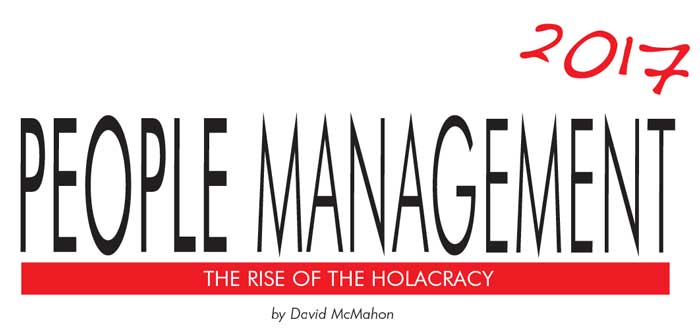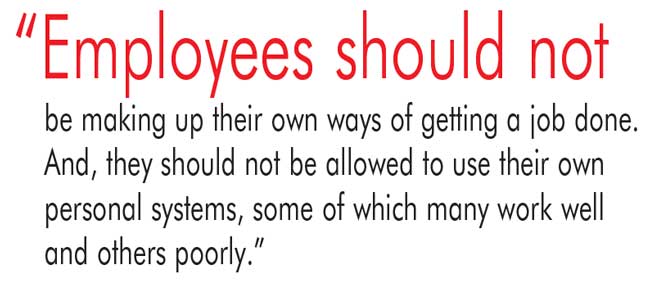
"People management is the toughest challenge we face. Managing, training, motivating, and keeping people is a continual battle for us.”
Does the quote above sound familiar? Does some employee related issue come up every time you think you have things running smoothly? Are you having issues with managing your people to do the right things consistently?”
If so, you are not alone. These are common complaints from owners and managers in retail furniture store operations. “People management” is the number one challenge in retail today. I’ve heard this from those in our performance groups, from my consulting clients and I’ve seen it in survey results. Many small business owners out there firmly believe that there is a big issue with the available talent pool. Are they correct that it’s an external problem businesses face?
Maybe, maybe not.
There are some business people who don’t say these things because they experience employee challenges much less. When working with organized, successfully growing companies I often hear talk like this:
- “We have great people.”
- “We can find people because they want to work here.”
- “Our management and our people are the reasons for our success.”
- “I love working here!”
Clearly the minority of businesses say these kinds of things.
I do not think it is a coincidence that those that have this issue lean more toward chaos management than those that don’t. First, this article will look at why some organizations do better than others in people management. Then we will take a close look at what you can do to overcome this challenge in 2017 .
My theory of management is that managers should lead – not manage their people. Instead, they should focus their attention on managing efficient systems and processes.
It is almost impossible to train someone to act as if they were a different person. Personalities, attitudes, habits and beliefs are what make people unique. These are not attributes that can be easily and directly managed or molded to conform to your personal or corporate belief or stereotype, so don’t try.

So, if you are a manager who doesn’t manage your people, what do you do? As mentioned above, you lead. Think of leading as a high-level people-related activity and management as a detailed process-related activity. Showing an employee how an activity should be executed is leadership. Reviewing whether the activity is being delivered properly and getting the desired results is management.
Furniture operations with less chaos seem to perform better because their employees have solid, well-defined systems that were set up for them to follow. These employees, therefore, tend to get their jobs done better. They know what they need to do, how to do it and when to do it. There is no confusion. The result is that once efficient systems are in place, managers have more time to lead. They don’t need to waste time individually micro-managing their employees. Employees should not be making up their own ways of getting a job done. And, they should not be allowed to use their own personal systems, some of which work well and others poorly. Simply put: Systems define outcomes. Good systems, when managed well, produce good outcomes. Bad systems that go unmanaged or the absence of defined systems altogether will waste time and produce chaos. Good leadership sets the direction, sets an example and sets the “tone” of the organization. True leadership instills belief. Employees know the processes being executed day-in and day-out are just.
Here is a basic process that management can use to develop systems that will lead their people to consistently producing more desired outcomes.
1. Define the system. A system is a way of doing things. Don’t confuse it with computer IT. A system contains ALL practices and ALL actions to accomplish a desired result. Every position should have a defined system in which to perform the job. The system needs to be documented and visually flow-charted. Verbal systems are lost in translation. As in the game of “Telephone” verbal messages that describe systems get garbled as they are passed along. Systems should be both efficient and effective. Efficient means the task is being performed in the right way. Effective means that it is the right task to achieve the desired result. I’ve seen many people waste a ton of time and money doing things efficiently but without any positive effect on the business. Top systems are a critical first step.
2. Train in the system. It is not enough to just give people a documented system with a flowchart and expect them to follow it and make it work. If they do read it, they will likely forget about it. A manager who is a good leader continuously demonstrates the system and practices it with the team. To be really successful, an organization must champion its systems and embrace the value. Constantly complaining about shortcomings is detrimental. If you have an issue with internal complaining, there is likely a leadership or culture issue other than just poor systems. Remember though, after you have your system defined there is only one way to mastery of it: continual practice doing the right things the right way.
3. Execute the system. All employees (managers and non-managers) should know: There are defined systems, procedures, and processes to follow. It is everyone’s job to execute the system. If they do not wish to execute it, make suggestions to improve it for everyone. If someone comes to you with a problem in your system, ask them to bring you a solution. Don’t make ad hoc changes for individual employees. Hold firm to this or you will end up with malfunctioning systems and a chaotic environment, producing sub-optimal results.
4. Manage the system. A sales manager should manage the selling and CRM systems. A delivery manager should manage the outgoing delivery system. A warehouse manager should manage the inventory control and transfer system. A marketing manager should mange the marketing system. An office manager should manage the AP, AR and cash receipts systems. An operation manager or GM should manage the entire business system. All employees under the manager are responsible for managing and executing their systems. All managers should have a weekly operations meeting to review and ensure the various systems are functioning correctly together.
5. Refine the system. Things change. It you ever think that you have the perfect operation you are opening yourself up to lost opportunities and possible big problems. It is a fact that there will always be constraints, or weak links that are under-performing. Operators who achieve great results NEVER consider themselves perfect. The best operators are those that consistently improve the management of their systems. It is their growth enabler. A good way of doing things today may not be a good way of doing things tomorrow. Always seek to locate areas that can be improved and your overall results will also improve.
The Zappos Holacracy
If you think I’m wrong here with regards to the role of managers, google the word Holacracy. It is a movement that has been adopted by companies like Zappos with positive results. Holacracy eliminates the traditional role of management. I recently visited Zappos, an Amazon company, to witness this first hand. Zappos has created work-circles which are responsible for managing certain job functions. There is a leader but no formal manager. Together, they work to improve their processes and get the particular job done better. They do not have a manager directing the people to do things. In fact, founder Tony Hirsch, still works in the same environment as everyone else, open room, small desk, no office. Zappos believes that this organization structure is best for what they value most – their culture. It takes about two months to bring a new hire on-board, as Zappos wants to be confident in the fit, and if someone wants to leave their organization, they will pay one months’ salary no questions asked to leave immediately. A takeaway from this: all employees in an organization should fit together and work together toward a common mission, while sharing a common culture.
I think that some well-run businesses and good managers out there are actually embracing a type of Holacracy subconsciously within their organization, they just don’t call it that or realize it’s happening. In today’s world, businesses are becoming flatter. To me this means that traditional layers of management are focusing more on task accomplishment rather than people-management. In the end, the people in a business get closer to the ultimate decision maker – the customer.
Whether Holacracy will flourish or not, the future of work is changing. It is advisable for business people to be aware of what people now expect and desire in a workplace.
I would bet on a purpose-driven organization with leaders of people and managers of systems winning customers over a competitor, any day.